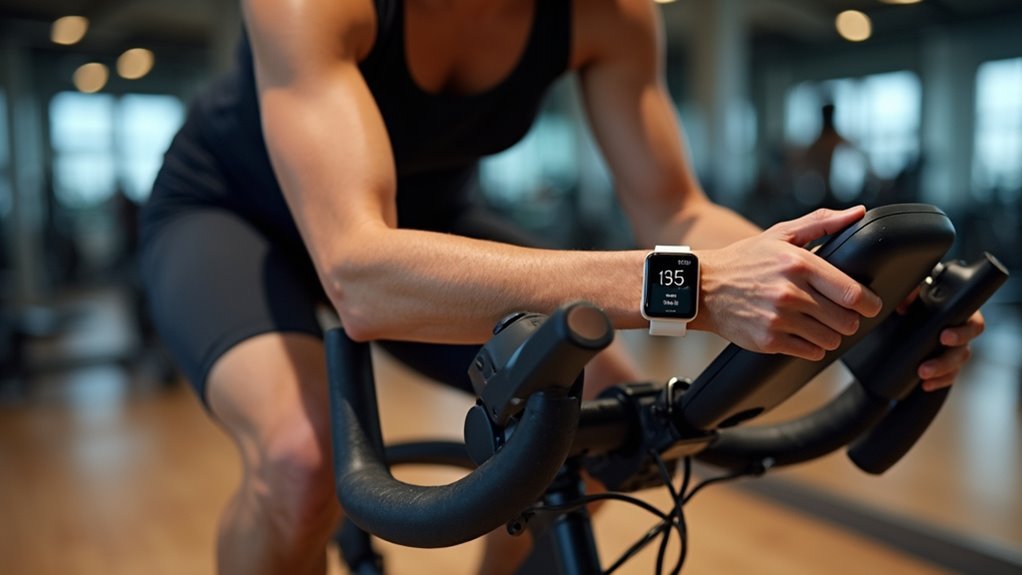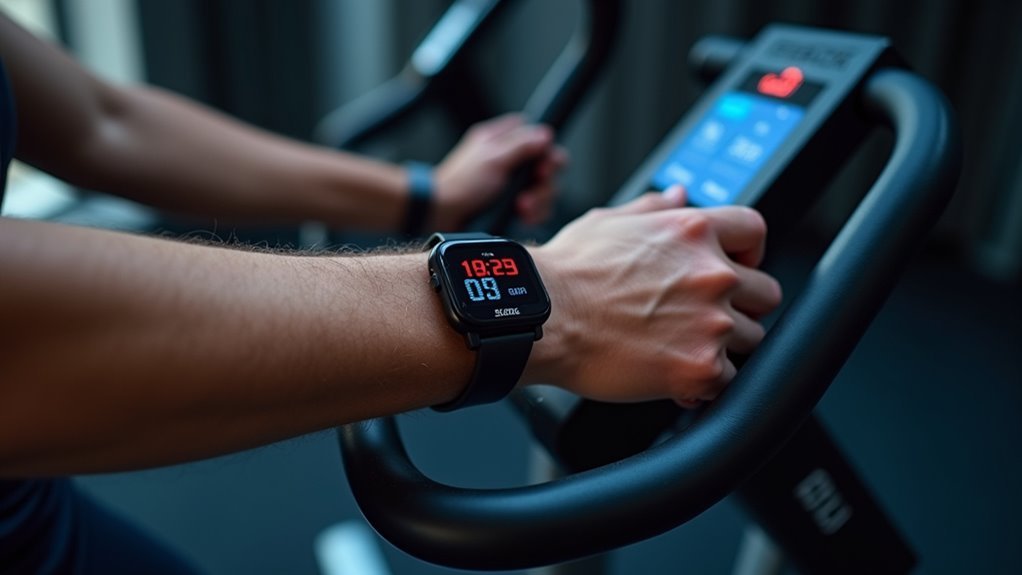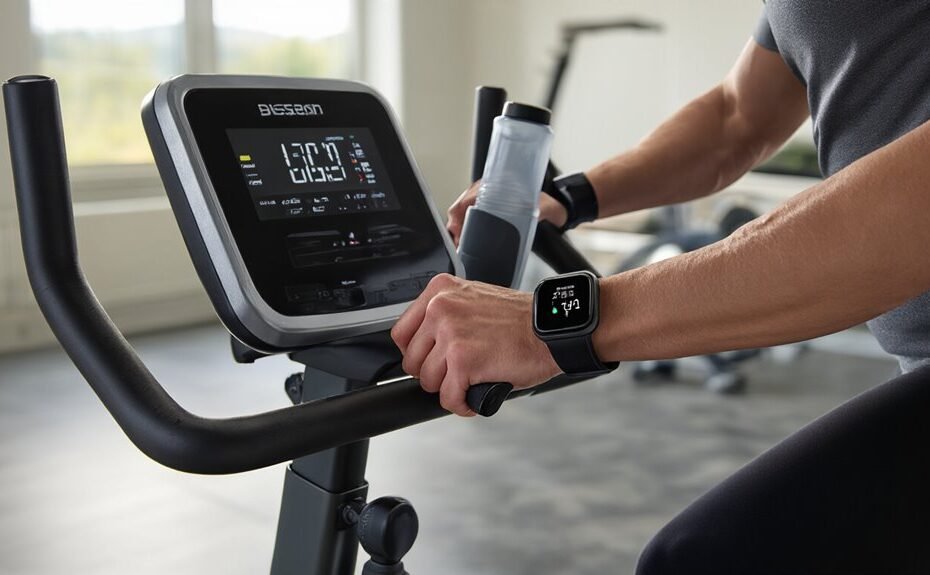Heart rate monitors come in various forms for stationary bike users, but finding the right one depends on specific needs. Chest straps typically offer better accuracy—within a few beats per minute—while wrist-based options provide convenience at the cost of some precision. Well, connectivity matters too; Bluetooth or ANT+ compatibility guarantees your workout data syncs seamlessly with fitness apps. Price points range widely, but even budget-friendly models like the CooSpo deliver reliable performance for most indoor cyclists. The question isn’t just which monitor is best, but which features actually matter for your training goals.
Some of the links in this article may be affiliate links. If you make a purchase through these links, we may earn a small commission at no extra cost to you. Thank you.
Chest Strap Monitors vs. Wrist-Based Options for Indoor Cycling
When it comes to tracking heart rate during indoor cycling sessions, cyclists face an important choice between chest strap monitors and wrist-based options.
Chest straps generally provide superior accuracy, which is essential for optimizing training sessions. They transmit real-time data via Bluetooth or ANT+ to connect seamlessly with stationary bikes.
While wrist-based heart rate monitors offer convenience, they often struggle to maintain precision during high-intensity indoor cycling workouts. The optical sensors just can’t keep up when you’re really pushing yourself.
For serious cyclists focused on performance metrics, chest straps remain the preferred choice despite being slightly less comfortable. They’re simply more reliable when every heartbeat matters.
Top Heart Rate Monitors Compatible With Stationary Bikes
When choosing a heart rate monitor for a stationary bike, the battle between chest straps and wrist-based options often comes down to personal preference and specific workout needs.
Chest strap monitors typically provide more accurate readings during intense indoor cycling sessions, while wrist options offer greater convenience but may lag during rapid heart rate changes.
Connectivity features like ANT+ and Bluetooth compatibility are essential considerations, as they determine whether your monitor will seamlessly integrate with your stationary bike’s console or preferred fitness apps.
Chest Straps Vs Wrist
Although both chest straps and wrist monitors offer convenient ways to track your heart rate during indoor cycling sessions, they differ considerably in accuracy and functionality.
Chest straps generally provide more reliable heart rate data, especially when hitting intense training zones during cycling workouts. The Garmin HRM-Dual, for instance, delivers consistent readings without the interference that often affects wrist-based monitors.
While wrist monitors offer convenience for casual riders, serious cyclists might find the extended battery life and precision of chest straps worth the slight comfort adjustment.
For those focused on maintaining specific heart rate zones during structured training, the marginal discomfort of a chest strap typically outweighs the occasional inaccuracies of wrist-based alternatives.
Connectivity Options Matter
Why do connectivity options make or break your stationary bike experience? When it comes to heart rate monitors, the right connectivity guarantees seamless data flow between your chest strap and bike.
Bluetooth and ANT+ compatibility isn’t just tech jargon—it’s essential for accurate performance tracking.
Three top options for connectivity include:
- Garmin HRM-Dual with dual Bluetooth and ANT+ technology
- Wahoo Tickr with internal memory for workouts without devices
- 4iiii Viiiiva that bridges ANT+ sensors to Bluetooth devices
Most stationary bikes work best with dual-protocol monitors, eliminating frustrating mid-workout disconnections.
Your perfect ride deserves reliable heart rate data.
How Accurate Are Different Heart Rate Monitoring Methods

Just how accurate is your heart rate monitor during an intense cycling session? The difference between chest straps and optical sensors can be significant when your performance analysis depends on reliable data. Chest straps typically maintain accuracy within ±1-3 beats per minute, while optical sensors might be off by up to ±10 BPM during vigorous pedaling.
| Monitor Type | Accuracy | Best For | Sweat Resistance |
|---|---|---|---|
| Chest Strap | ±1-3 BPM | Precision training | Excellent |
| Wrist Optical | ±5-10 BPM | Casual rides | Good |
| Built-in Handlebar | ±7-12 BPM | Basic feedback | Fair |
| Earbuds | ±3-6 BPM | Comfort-focused riders | Very Good |
Your training needs should dictate your choice.
Heart Rate Zones and Their Importance in Indoor Cycling
Heart rate zones represent the foundation of effective indoor cycling training. Understanding these zones—calculated as percentages of your maximum heart rate (typically 220 minus age)—helps cyclists optimize their workouts for specific goals and avoid overtraining.
When you monitor heart rate during indoor sessions, you’ll target different training benefits:
- Fat-burning zone (60-70%): Ideal for beginners and recovery rides
- Aerobic zone (70-80%): Perfect for building endurance and cardiovascular fitness
- Anaerobic zone (80-90%): Great for performance improvements and interval training
Real-time feedback from a good heart rate monitor keeps you in your target heart rate zones, which is essential for tracking progress and making those effective indoor cycling sessions count toward your fitness goals.
Connectivity Features That Matter for Stationary Bike Integration

Once you’ve established your ideal heart rate zones for training, the next consideration becomes how your monitor will actually communicate with your stationary bike.
Connectivity options like Bluetooth and ANT+ are essential—they determine whether your device will pair seamlessly with your bike and favorite fitness apps.
A monitor that offers real-time data transmission gives you immediate feedback during cycling sessions, helping you maintain proper intensity.
Look for models with internal memory too, as they’ll track workouts even when you’re not connected to another device.
Don’t overlook comfort—a secure, washable strap prevents interruptions while you’re pushing through those challenging intervals.
Budget-Friendly Heart Rate Monitors That Don’t Sacrifice Quality
Many athletes believe premium pricing guarantees quality, but that’s not always the case with heart rate monitors.
Budget-friendly options for stationary biking offer reliable performance without emptying your wallet.
- CooSpo Heart Rate Monitor – At around $30, this waterproof chest strap delivers accurate readings via Bluetooth and ANT+ connections.
- Polar H9 – A dependable mid-range option that won’t break the bank while providing precise heart rate data during intense indoor cycling sessions.
- Garmin HRM Dual – For approximately $59, you’ll get real-time data transmission through both Bluetooth and ANT+, perfect for connecting to various stationary bike systems.
Frequently Asked Questions
What Is the Best Fitness Tracker for a Stationary Bike?
For stationary bikes, the Wahoo Tickr X offers superior tracking accuracy, cadence metrics and mobile app compatibility. The Garmin HRM-Dual provides reliability, while CooSpo remains a budget-friendly choice with user-friendly features.
What Should My Heart Rate Be When Riding a Stationary Bike?
With time being of the essence, ideal heart zones while cycling should be 50-85% of one’s maximum heart rate (220 minus age), varying with fitness goals and cycling intensity levels when monitoring heart rate.
Is It Worth Having a Heart Rate Monitor for Cycling?
Heart rate monitors provide substantial value for cycling by tracking workout intensity, establishing training zones, and monitoring recovery heart rate. They help cyclists optimize heart health, achieve fitness goals, and measure progress effectively.
How Do You Do the Max Heart Rate Test on a Stationary Bike?
Over 70% of people miscalculate their max heart rate. To test on a stationary bike, warm up, increase resistance every 1-2 minutes until exhaustion, record peak heart rate, then cool down gradually. Consider fitness level and safety precautions.
